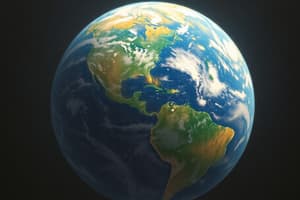Podcast
Questions and Answers
What is the shape of the Earth?
What is the shape of the Earth?
- Oblate spheroid (correct)
- Perfectly flat
- Elliptical
- Perfect sphere
What is the reason for the Earth's bulging at the equator?
What is the reason for the Earth's bulging at the equator?
- The Earth's axis of rotation
- Wind and water erosion
- The movement of tectonic plates
- Gravitational force caused by the Earth's rotation (correct)
What is the direction of the Earth's rotation?
What is the direction of the Earth's rotation?
- From east to west
- From south to north
- From west to east (correct)
- From north to south
What is the time taken by the Earth to complete one rotation around its axis?
What is the time taken by the Earth to complete one rotation around its axis?
What is the angle of tilt of the Earth's axis of rotation?
What is the angle of tilt of the Earth's axis of rotation?
What is the result of the gravitational pull between the sun and the moon on Earth?
What is the result of the gravitational pull between the sun and the moon on Earth?
What is the speed of Earth's revolution around the sun?
What is the speed of Earth's revolution around the sun?
What occurs when the Tropic of Cancer faces the sun?
What occurs when the Tropic of Cancer faces the sun?
How many days does it take for the Earth to complete one revolution around the sun?
How many days does it take for the Earth to complete one revolution around the sun?
What is the result of the Earth's tilt?
What is the result of the Earth's tilt?
Flashcards are hidden until you start studying
Study Notes
The Shape of the Earth
- Earth is one of eight planets in our solar system and has a slightly greater radius at the Equator.
- The Earth's shape is an oblate spheroid, meaning it is not perfectly round, but slightly flattened at the poles and bulging in the middle.
- This shape is due to the gravitational force caused by the Earth's rotation.
Evidences of the Earth's Shape
- Places in the east see the rising Sun earlier, indicating that the Earth is not flat.
- When a ship approaches land, its funnel or mast is seen first, and then the hull, providing evidence that the Earth is not flat.
Movements of the Earth
Rotation
- Rotation is the movement of the Earth on its axis, taking about 24 hours to complete one rotation.
- The Earth rotates from west to east, causing the sun to appear to rise in the east and set in the west.
- The axis of rotation is tilted at an angle of 23.5° and is perpendicular to the Earth's orbit, influencing daylight, temperature, and weather patterns from season to season.
Effects of Earth's Rotation
- Rotation creates a diurnal cycle of light and darkness, temperature, and humidity changes.
- As the Earth rotates, half of the Earth faces the sun and half faces away from the sun, causing day and night.
High and Low Tide
- High and low tide is a result of the gravitational pull between the Sun and the Moon.
- As the Earth rotates, the Sun and the Moon pull on the Earth, causing high and low tide.
Revolution of the Earth
- Revolution is the movement of the Earth around the Sun in a fixed path or orbit.
- The time for one revolution is 365¼ days or one year, and the speed of Earth's revolution is 68,000 miles per hour.
Effects of Revolution of the Earth
- The revolution of the Earth gives the impression that the Sun is moving north and south of the equator.
- The equator faces the Sun directly on March 21 and September 23, resulting in equal day and night throughout the Earth, known as equinoxes.
- The revolution causes variation in the length of day and night.
Seasons
- The revolution of the Earth causes the four seasons:
- Summer (Kiremt)
- Autumn (Meher)
- Winter (Bega)
- Spring (Belg / Tsedey)
- The seasons result from the tilt of the Earth's axis and the revolution around the Sun.
Studying That Suits You
Use AI to generate personalized quizzes and flashcards to suit your learning preferences.




